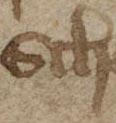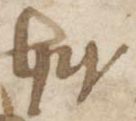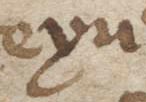|
| A |
 | Usage: bakbite
double compartment 'a' is used throughout. |  | Usage: falsenesse
the hairline closing stroke across the head is sometimes difficult to see. |
 | Usage: Al
this 'A' appears at the beginning of a line and may be a variant on the example shown in version 4. |  | Usage: And
possibly the more usual shape for the scribe's upper case 'A's. |
|
| D |
 | Usage: dispyce
looped 'd' is used throughout. The lower lobe is generally rounded. |  | Usage: grauntid
the upper loop is usually quite large compared with the lobe. |
 | Usage: mede
biting between the 'd' and following 'e'. |  | Usage: Erledom |
|
| G |
 | Usage: grau(n)tteþ
'g' is anglicana generally comprising two rounded compartments. |  | Usage: chidyng
the lower compartment is often slightly in advance of the upper compartment. |
 | Usage: brogages |  | Usage: Glotony
a degraded portion of the folio but just possible to see the scribe's upper case 'G'. |
|
| H |
 | Usage: haþ
the head-loop of 'h' is generally triangular in shape and extends beyond the line of the shoulder. |  | Usage: hit
the limb may be straight or curved. There may be either a small flick or a wider curve of the tail-stroke counter-clockwise. |
 | Usage: schow |  | Usage: hir |
|
| R |
 | Usage: rede
long 'r' is used in all positions. |  | Usage: ber |
 | Usage: brogages
'z'-shaped 'r' is used after 'o' and other round-bodied graphs. |  | Usage: Ire |
|
| S |
 | Usage: seyed
both sigma 's' and long 's' are used in initial position. |  | Usage: symony |
 | Usage: fals
sigma 's' is also used in final position. |  | Usage: Sciant
the scribe's upper case graph at the beginning of the Latin heading which is underlined in red ink. |
|
| W |
 | Usage: wot
the shape of 'w' is usually the same. The head may be looped or left open. |  | Usage: schow |
 | Usage: wittenesse |  | Usage: Witten
a slightly more impressive graph as the upper case letter. |
|
| Y |
 | Usage: ydel
'y' does not vary very much. It may be dotted or undotted. |  | Usage: envy
the dotted version in final position. |
 | Usage: symony
the angle of the tail turning counter-clockwise is similar in all examples. |  | Usage: fasteyndayes |
|
| Thorn and Yogh |
 | Usage: þei
thorn is used quite frequently, not only in the usual places but also as replacement of 'th'. |  | Usage: haþ |
 | Usage: þoȝthes
yogh is only used a couple of times on this folio as equivalent to 'gh'. |  | Usage: sleȝthes |






































